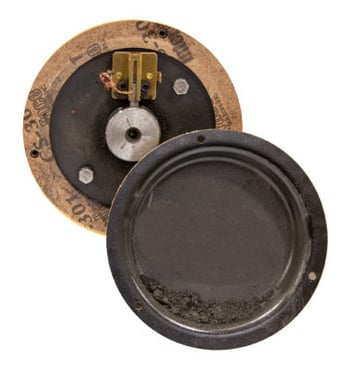Q1. I've heard that AEGIS® Ring you've made, to date, was 44" (112 cm), for a hydroelectric turbine. What is the smallest shaft size that you can make AEGIS Rings for?
 A1. Our standard rings go down to 0.311" (7.9 mm). But for even smaller - say 1/8" - we've made little button brushes, that contact the shaft axially instead of radially. Some of these tiny rings are for satellites with solar panels - the panels need to be oriented to face the sun, and that's what these little motors do.
A1. Our standard rings go down to 0.311" (7.9 mm). But for even smaller - say 1/8" - we've made little button brushes, that contact the shaft axially instead of radially. Some of these tiny rings are for satellites with solar panels - the panels need to be oriented to face the sun, and that's what these little motors do.
Q2. Are all AEGIS Rings made of aluminum, or an alloy, or some other metal?
A2. The base metal is typically aluminum. It's highly conductive and lightweight, and it machines and handles well. But we can and do use other metals, like stainless steel. The US Navy & chemical plants use a lot of stainless grounding rings. We also see special applications that use nickel plating and other coatings.
Q3. There are several US-based motor manufacturers who factory-install AEGIS Rings. Are there motor manufacturers in Europe who install AEGIS as an option?
A3. Yes. Just like in the US, many EU manufacturers have evaluated AEGIS rings and decided they should offer them. Three large ones are ABB, Leroy-Somer (Nidec), & WEG.
Q4. What are AEGIS' competing products, & what makes AEGIS better?
 A4. The most common is probably the carbon brush. It's a little spring-loaded carbon block, doped with metal. It sits in a metal holder, with a spring to press the block against the motor shaft. There are a few problems with this, like wear and dust. The image to the right is a carbon brush that was inside the motor at the nondrive end. In the foreground is the motor fan shield, holding several grams of dust that wore off the brush. You can find more detail here.
A4. The most common is probably the carbon brush. It's a little spring-loaded carbon block, doped with metal. It sits in a metal holder, with a spring to press the block against the motor shaft. There are a few problems with this, like wear and dust. The image to the right is a carbon brush that was inside the motor at the nondrive end. In the foreground is the motor fan shield, holding several grams of dust that wore off the brush. You can find more detail here.
There are also devices called common mode chokes. The new marketing term is "inductive absorbers." Whatever you call them, they are rings of ferrite that you run the motor's power cables through. Without getting too far into it, they do confer a few benefits. But they don't protect motors against the same problem that AEGIS Rings do. See Question 3 here for more detail. So the bottom line is, if you use them, you still need an AEGIS Ring for protection against shaft voltage.
AEGIS Rings also come with a 2-year extended warranty against bearing fluting damage. No other form of protection against VFD-caused bearing damage offers a warranty like this.
To learn more about AEGIS shaft grounding and best practices for electrical bearing protection, sign up for a training. We offer monthly live training webinars, and - pandemic restrictions permitting - we can also visit your facility to review your exact application.



